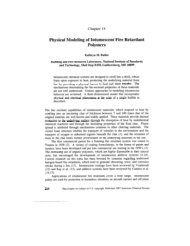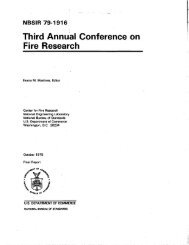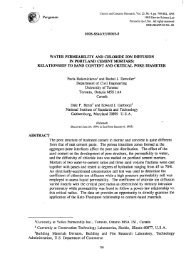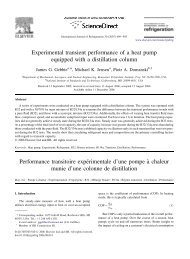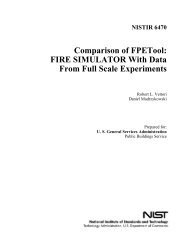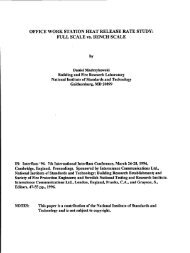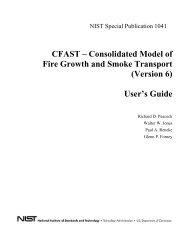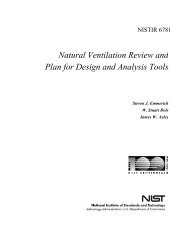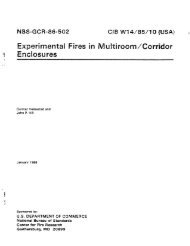Study of Technology for Detecting Pre-Ignition Conditions of ... - NIST
Study of Technology for Detecting Pre-Ignition Conditions of ... - NIST
Study of Technology for Detecting Pre-Ignition Conditions of ... - NIST
You also want an ePaper? Increase the reach of your titles
YUMPU automatically turns print PDFs into web optimized ePapers that Google loves.
in Section 3.7.2 is valid, or if a wide range <strong>of</strong> behaviors accompanies the heating <strong>of</strong> sugar. Since<br />
the status <strong>of</strong> the hood did not affect ignition conditions in a clear rnmer. the presence or absence<br />
<strong>of</strong> a range hood <strong>of</strong> similar capacity to this one or whether such a range hood is active or not<br />
should not significantly affect the inputs to a detector sensing any <strong>of</strong> the conditions measured in<br />
these experimen~.<br />
3.7.4 Pan Material<br />
A flmmable liquid food cooked in an aluminum pan tended to reach ignition conditions<br />
slowly, if at all, when wmpmed to heating the same food in a stainless steel pan <strong>for</strong> the ranges<br />
used in this study. The use <strong>of</strong> stainless steel in the -pans always produced ignition <strong>for</strong> oils and<br />
fatty meat under high heating <strong>for</strong> these particular ranges. The reason <strong>for</strong> this is the high thermal<br />
mnductivi~ ( 1’70Witi) and thermal diffbsivity (70x I 0-6 mzls) <strong>of</strong> aluminum which contribute<br />
to high heat losses to the sides <strong>of</strong> the pan. Thermal mndu~ivi~, k, is a property <strong>of</strong> a material<br />
that describes the relative ease <strong>of</strong> heat mndutiion through it. The thermal difisivity <strong>of</strong> a<br />
material, oi, describes the relative ease <strong>of</strong> heat wnduaion tiou@ it mmpwed to its capacity <strong>for</strong><br />
energy storage. Stainless steel has much lower values <strong>of</strong> these thermal properties (k = 15 W/rnK,<br />
01 = 4x10-6 m2/s) which gives it a tendency to retain more heat than a material with higher<br />
property values. Heat easily condu~ed to the sides <strong>of</strong> an aluinum pan is then transferred to the<br />
air due to the much greater contact area between hot metal and air mmpmed to the stainless steel<br />
case in which the walls are relatively cool compared to the bottom, and the pan’s high<br />
temperawres are concentrated where air does not come into contact.<br />
3.8 Reproducibili@<br />
Seven <strong>of</strong> the experiments were repeated with the same conditions to determine test-to-test<br />
variation <strong>of</strong> the recorded variables. The experiments were very reproducible. Differences<br />
between the maximum memurement values and the heating times required <strong>for</strong> ignition <strong>of</strong> repeated<br />
tests were &picalIy less than 10 ‘A and <strong>of</strong>ten under 5 ‘A. Two figures are provided to illustrate<br />
these typical variations.<br />
Figure 36 shows a comparison <strong>of</strong> the pan-centerline tempera~res 16.8 cm above the<br />
burner and the pan-side temperatures bemeen two tests <strong>of</strong> bacon rooked on the electric range<br />
with the hood <strong>of</strong>f. The heating time required to produce ignition conditions <strong>for</strong> test 9510 was<br />
31 seconds (6.7 Yo) greater than that required <strong>for</strong> test 9502. Just be<strong>for</strong>e ignitio~ the centerline<br />
temperawre <strong>for</strong> test 9502 was approximately 20 ‘C (5.2 Yo) greater than that <strong>of</strong> test 9510. The<br />
pan-side tempera~re <strong>for</strong> test 9510 was approximately 33 ‘C (5.4 ‘?40) greater than that <strong>of</strong> test<br />
9502. The maximum temperatures, temperature trends, and heating periods were similar <strong>for</strong> each<br />
<strong>of</strong> these tests.<br />
Figure 37 shows a mmpmison <strong>of</strong> Imer-attenuation memuremenfi 17.8 cm above the<br />
burner between two tests <strong>of</strong> oil cooked on the gas range with the hood on. The heating time<br />
required to produce ignition renditions <strong>for</strong> test 9516 was 34 seconds (3.6 ‘/0) greater than that<br />
required <strong>for</strong> test 9514. Just be<strong>for</strong>e ignition occurred, the attenuation level <strong>for</strong> test 9514 was<br />
4.89’0 (5.5 ?40, relatively) greater than that <strong>of</strong> test 9516. The mwimum atienwtion levels,<br />
58



